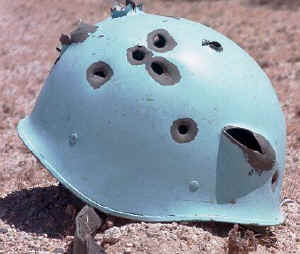 |
| Category: Conflicts |

|
|
|
|
|
|

|
The UN has adopted baby
blue as it's "trademark" colour for headgear.
The beret is the most common headwear
issued, although the Kevlar helmet in baby blue is sometimes seen as is
the UN bush hat. |
 |
- Although most UN missions are peace
keeping, not peace making, it does not guarantee that they are safe.
- This was not an Aussie or Kiwi
helmet.
|
|

|
 |
A total of three medallions have been
issued to denote service with UN peacekeeping and other missions. The
three are:
- Korea - A bronze medallion bearing on the
obverse the representation of the UN symbol in bas-relief and, on
the reverse, the wording (in bas relief)
"FOR SERVICE IN THE DEFENCE OF THE PRINCIPLES OF
THE CHARTER OF THE UNITED NATIONS"
- The medallion is attached to the ribbon by means of
a bar which bears the name "KOREA"
in bas-relief.
- The wording shown may be in English,
French, Spanish, Danish, Greek, Italian, Dutch, Swedish, Sanskrit or
Turkish.
|
|

|
-
UNEF 1 - First United Nations Emergency Force.
- Created by the UN as the First
United Nations Emergency Force and awarded to participating UN
soldiers from ten countries who secured and supervised the end of
hostilities on the Sinai Peninsula for six months of service between
November 1956 and June 1967.
- A bronze medallion bearing on the
obverse the representation of the UN symbol surmounted by the
letters "UNEF", both in bas-relief and, on the reverse,
the words "IN THE SERVICE OF PEACE" in bas-relief.
|
|

|
- Standard - A bronze medallion bearing on the
obverse the representation of the UN symbol surmounted by the
letters "UN" both in bas-relief and, on the reverse, the
words "IN THE SERVICE OF PEACE" in bas-relief. This
standard medallion is used for all missions except the two mentioned
above.
- Each mission has it's own ribbon.
- The one
shown here is for East Timor.
- For the other UN Medals go to
|
- All UN Medals are treated as
foreign medals on the Australian Order of Precedence (Order of
Wearing) with the sole exception of the UN Medal for Korea.
|
|